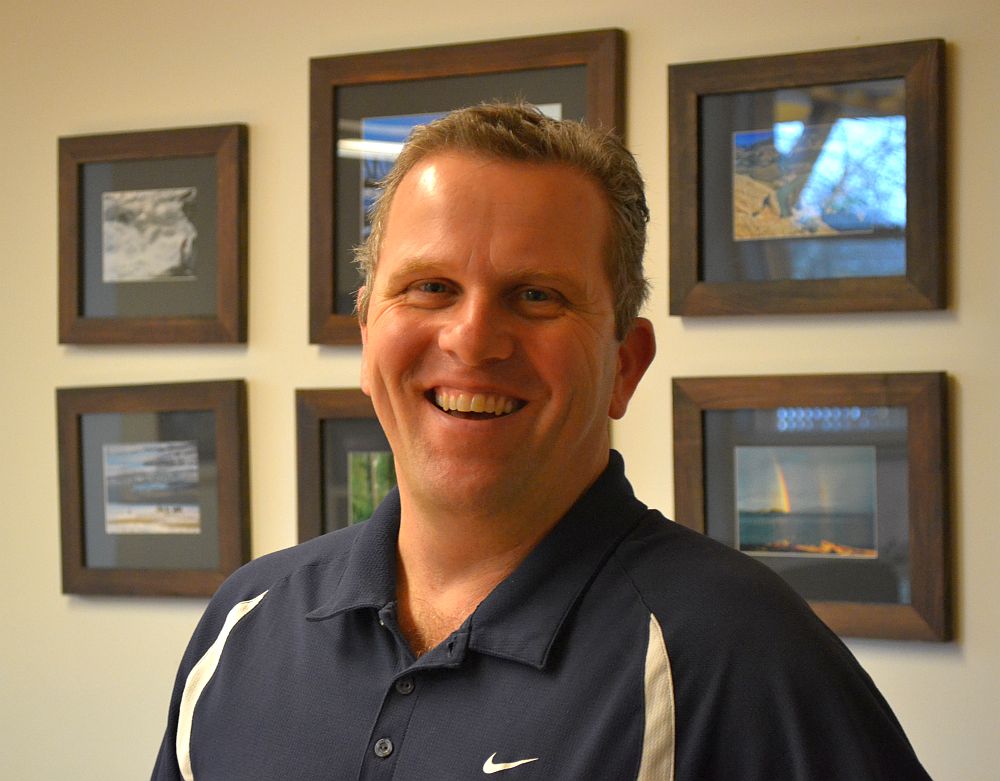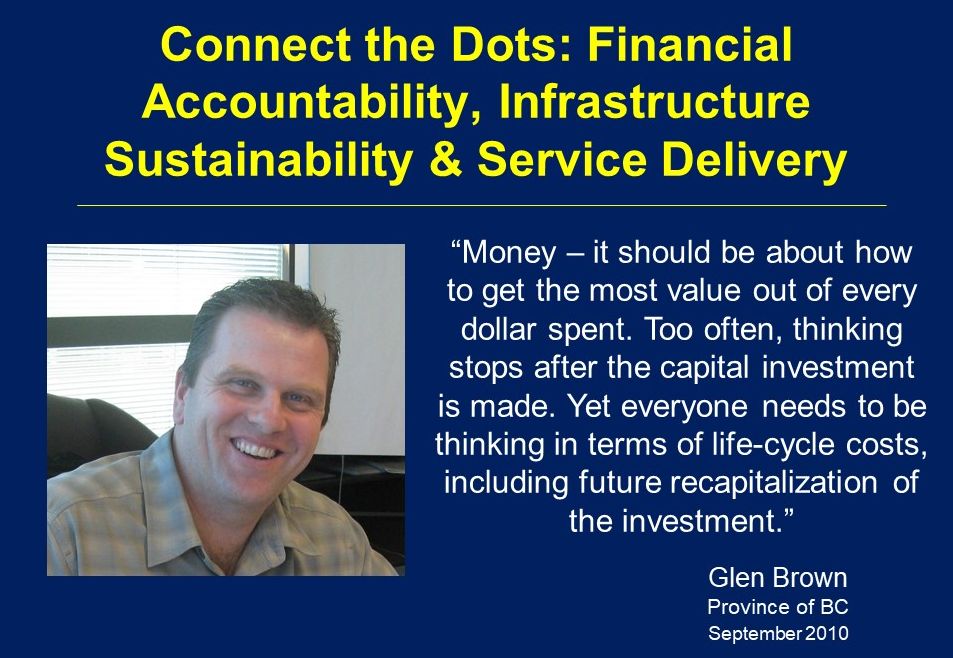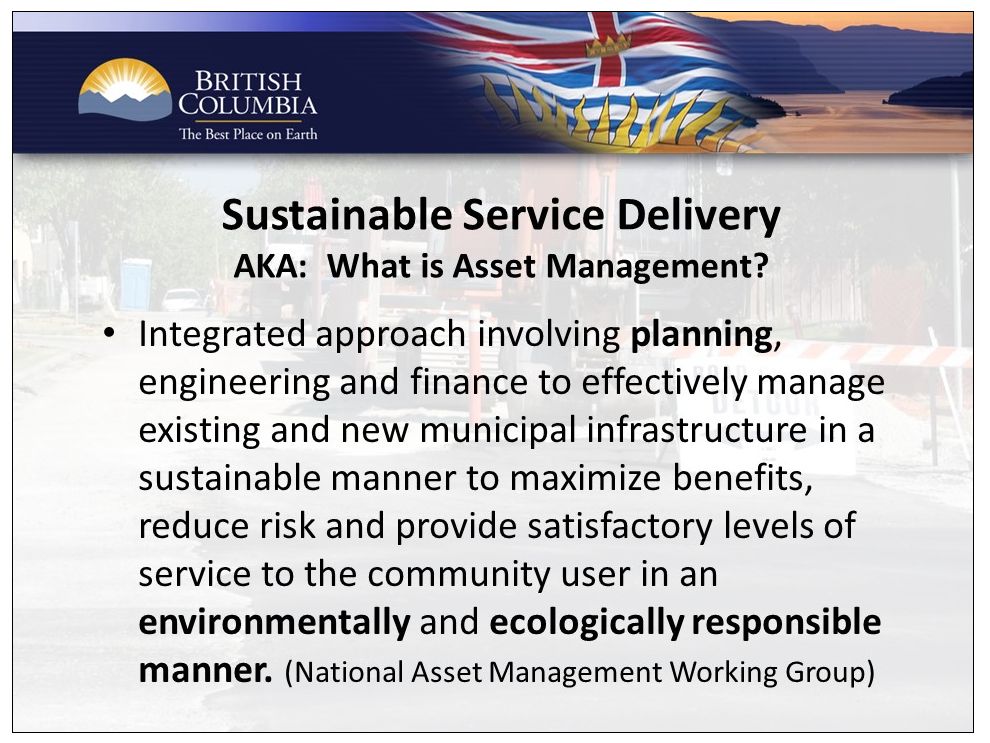FLASHBACK TO 2010: What was the genesis of the phrase ‘sustainable service delivery’ a decade ago? What was the process for mainstreaming the approach in British Columbia? How did it become an ‘actionable vision’ for local governments? As an outcome of the Worth Every Penny Workshop, Glen Brown synthesized three ideas into a single easy to remember phrase that became a game-changer!
Note to Reader:
The phrase “asset management for sustainable service delivery” is now an accepted part of the local government vocabulary in British Columbia. The phrase was formalized with release of Asset Management for Sustainable Service Delivery: A BC Framework in December 2014, and rollout in 2015.
Tranformational in its scope and vision for a desired outcome, this guidance document was the culmination of a multi-year process. It represents a personal and sustained commitment by Glen Brown, Chair of Asset Management BC to “make it happen”. Currently, he is the General Manager, Victoria Operations, for the Union of BC Municipalities (UBCM). Previously, he was the Deputy Inspector of Municipalities and the Executive Director for Infrastructure and Finance in the Ministry of Community Development.
What was the genesis of the phrase “sustainable service delivery”? What was the process for mainstreaming it? Both questions are addressed below in the retrospective written by Kim Stephens, Executive Director of the Partnership for Water Sustainability in British Columbia. He tells the story through a focus on the actions of Glen Brown as a key influencer in the world of government.

Sustainable Service Delivery: An Integrated Approach Links Land Use Planning, Watershed Health and Infrastructure Liability
“I remember the moment so well when Glen Brown coined the term ‘sustainable service delivery’ to capture what was in his mind. It was June 2010, and I was at the offices of the Regional District of Nanaimo. John Finnie and I were on a phone call with Glen. The purpose was to develop Glen’s part in the agenda for the Worth Every Penny Workshop,” recalls Kim Stephens.
 “It was the week after Glen had given a presentation at the Leadership Forum organized by the Local Government Leadership Academy. His title was Financial Accountability, Infrastructure Sustainability, Service Delivery: Connecting the Dots with an Asset Management Approach. Nowhere in the presentation did Glen use the term ‘sustainable service delivery’.
“It was the week after Glen had given a presentation at the Leadership Forum organized by the Local Government Leadership Academy. His title was Financial Accountability, Infrastructure Sustainability, Service Delivery: Connecting the Dots with an Asset Management Approach. Nowhere in the presentation did Glen use the term ‘sustainable service delivery’.
“During our brainstorming, Glen made repeated reference to the presentation; and expressed his desire to adapt it for the purposes of our upcoming event. As we talked, I kept pressing Glen to elaborate on what was in his mind so that we could help him crystallize a sound-bite for use as a compelling title.
“There was an Ah-ha Moment and the penny dropped. It was apparent to Glen, John Finnie and me that Glen’s headline should be What Does ‘Sustainable Service Delivery’ Mean to You?
“In a nutshell, what happened during that conversation was that Glen Brown synthesized three ideas into a single easy to remember phrase: Sustainable Service Delivery. The rest is history, as they say.”

It’s All About the Service
 “My inspiration came from Guy Felio, who is one of the original gurus of asset management nationally,” states Glen Brown. “In his own words, and in a slide (below) that I have seen him use in presentations since the mid-2000s, he said, ‘It’s all about the service’.
“My inspiration came from Guy Felio, who is one of the original gurus of asset management nationally,” states Glen Brown. “In his own words, and in a slide (below) that I have seen him use in presentations since the mid-2000s, he said, ‘It’s all about the service’.
“Basically, well-maintained infrastructure/assets are worthless IF they do not provide a service. That is what resonated with me. Also, for any asset management approach to be successful, it must not focus on the infrastructure/asset by itself.
“That way-of-thinking applies to nature and the environment as well – as long as we fully understand and appreciate the value of natural services – particularly when we leverage natural services to provide traditional community services, as well as those that are provided to support a healthy environment (clean air, aquatic habitat, etc.).”

2010 Worth Every Penny Workshop hosted by the Regional District of Nanaimo, and held in the City of Parksville
 Part of the rollout to stimulate a national dialogue on sustainable water management, the Nanaimo Region Water Pricing Workshop was described as the first of its kind in Canada. The workshop program was a unique blend of research and practice. The workshop connected the dots between three initiatives:
Part of the rollout to stimulate a national dialogue on sustainable water management, the Nanaimo Region Water Pricing Workshop was described as the first of its kind in Canada. The workshop program was a unique blend of research and practice. The workshop connected the dots between three initiatives:
- Action for Water, implemented by the Regional District of Nanaimo following approval in a referendum in November 2008.
- Worth Every Penny: A Primer on Conservation-Oriented Water Pricing, released in May 2010.
- Beyond the Guidebook 2010: Implementing a New Culture for Urban Watershed Protection and Restoration in British Columbia, released in June 2010.
The desired outcome for the workshop was that participating practitioners would understand why ‘conservation-oriented water pricing’ is a tool to achieve a larger end, that is: ‘sustainable service delivery’.
“Sustainable service delivery is an emerging issue in BC. Changing and/or additional demands mean the local government workload is expanding. Local governments are being challenged to maintain and/or replace existing infrastructure over time, and to ‘do more with less’,” stated Kim Stephens in a preview story published in 2020 about the workshop.
To Learn More:
For details of the program, click on Agenda for Nanaimo Region Water Pricing Workshop
Download a copy of the presentation by Glen Brown: Water for Life and Livelihoods on Vancouver Island: What Does ‘Sustainable Service Delivery’ Mean to You? Note that the presentation was delivered by Wally Walls on behalf of Glen because Glen took ill the night before the workshop.
The significance of Glen not being able to deliver his presentation in person meant that the unveiling of Sustainable Service Delivery in an outreach and professional development setting was delayed seven months until April 2011 when Glen was part of the faculty for the Comox Valley Leaning Lunch Seminar Series.
This landmark series was initiated by the Partnership for Water Sustainability, hosted by the four Comox Valley local governments, and held under the umbrella of CAVI, Convening for Action on Vancouver Island.



